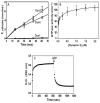The proline/arginine-rich domain is a major determinant of dynamin self-activation
- PMID: 21082776
- PMCID: PMC3017478
- DOI: 10.1021/bi101343p
The proline/arginine-rich domain is a major determinant of dynamin self-activation
Abstract
Dynamins induce membrane vesiculation during endocytosis and Golgi budding in a process that requires assembly-dependent GTPase activation. Brain-specific dynamin 1 has a weaker propensity to self-assemble and self-activate than ubiquitously expressed dynamin 2. Here we show that dynamin 3, which has important functions in neuronal synapses, shares the self-assembly and GTPase activation characteristics of dynamin 2. Analysis of dynamin hybrids and of dynamin 1-dynamin 2 and dynamin 1-dynamin 3 heteropolymers reveals that concentration-dependent GTPase activation is suppressed by the C-terminal proline/arginine-rich domain of dynamin 1. Dynamin proline/arginine-rich domains also mediate interactions with SH3 domain-containing proteins and thus regulate both self-association and heteroassociation of dynamins.
Figures



References
-
- Praefcke GJ, McMahon H. Nat Rev Mol Cell Biol. 2004;5:133–147. - PubMed
-
- Ramachandran R. Semin Cell Dev Biol. 2010 [Epub Sep 15, PMID:20837154]
Publication types
MeSH terms
Substances
Grants and funding
LinkOut - more resources
Full Text Sources

